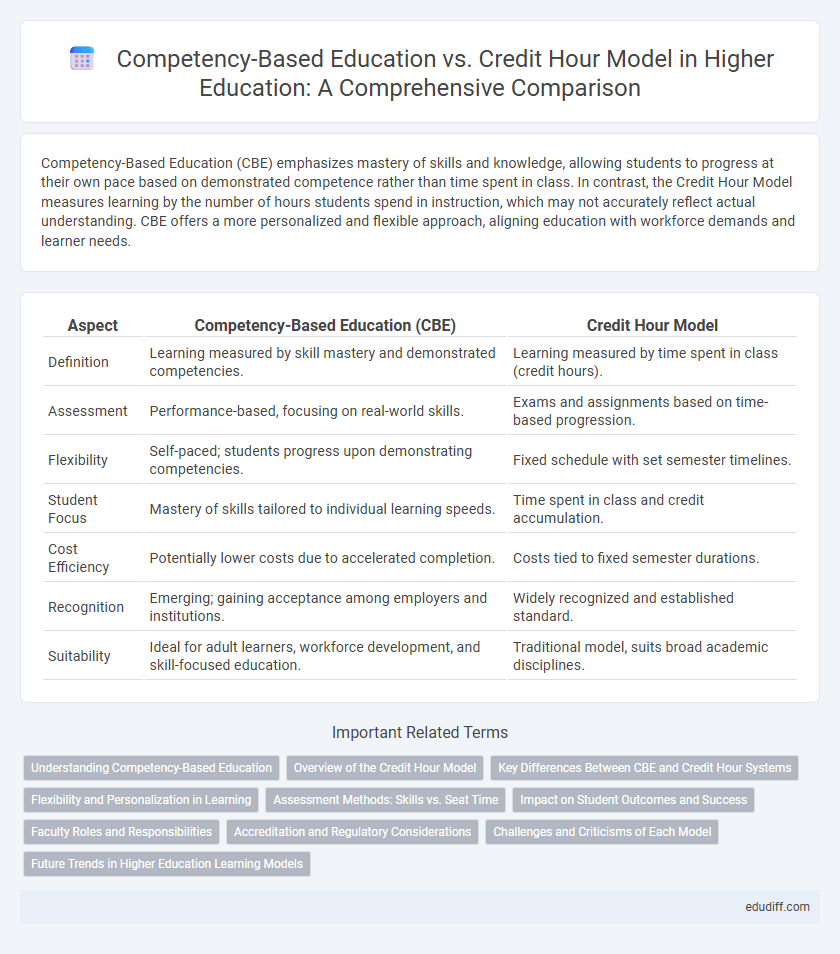Competency-Based Education (CBE) emphasizes mastery of skills and knowledge, allowing students to progress at their own pace based on demonstrated competence rather than time spent in class. In contrast, the Credit Hour Model measures learning by the number of hours students spend in instruction, which may not accurately reflect actual understanding. CBE offers a more personalized and flexible approach, aligning education with workforce demands and learner needs.
Table of Comparison
| Aspect | Competency-Based Education (CBE) | Credit Hour Model |
|---|---|---|
| Definition | Learning measured by skill mastery and demonstrated competencies. | Learning measured by time spent in class (credit hours). |
| Assessment | Performance-based, focusing on real-world skills. | Exams and assignments based on time-based progression. |
| Flexibility | Self-paced; students progress upon demonstrating competencies. | Fixed schedule with set semester timelines. |
| Student Focus | Mastery of skills tailored to individual learning speeds. | Time spent in class and credit accumulation. |
| Cost Efficiency | Potentially lower costs due to accelerated completion. | Costs tied to fixed semester durations. |
| Recognition | Emerging; gaining acceptance among employers and institutions. | Widely recognized and established standard. |
| Suitability | Ideal for adult learners, workforce development, and skill-focused education. | Traditional model, suits broad academic disciplines. |
Understanding Competency-Based Education
Competency-Based Education (CBE) emphasizes mastery of specific skills and knowledge, allowing students to progress upon demonstrating proficiency rather than time spent in class. This model tailors learning to individual pace, promoting deeper understanding and practical application relevant to career and life demands. CBE contrasts with the traditional credit hour system, which measures progress primarily by time rather than actual competencies achieved.
Overview of the Credit Hour Model
The Credit Hour Model structures academic progress based on the number of hours students spend in class, typically requiring 120 to 130 credit hours for a bachelor's degree. This model emphasizes seat time and standardized pacing, ensuring students complete a fixed amount of instructional time per course. Institutions widely use it, with accreditation bodies often linking degree requirements directly to credit hour thresholds.
Key Differences Between CBE and Credit Hour Systems
Competency-Based Education (CBE) measures student progress through demonstrated mastery of specific skills and knowledge, allowing flexible pacing tailored to individual learning speeds, whereas the Credit Hour Model relies on fixed time spent in class for course completion. CBE emphasizes outcomes and real-world application, fostering personalized instruction and continual assessment, while the Credit Hour system is structured around seat time and standardized curriculum delivery. This fundamental shift in approach impacts curriculum design, assessment strategies, and student engagement within higher education institutions.
Flexibility and Personalization in Learning
Competency-Based Education (CBE) offers greater flexibility by allowing students to progress at their own pace based on mastery of specific skills, contrasting with the rigid time-based Credit Hour Model. This personalized approach in CBE caters to diverse learning styles and schedules, enabling learners to demonstrate competencies through assessments rather than seat time. Institutions adopting CBE can enhance learner engagement and outcomes by tailoring education to individual needs, promoting practical proficiency over standardized credit accumulation.
Assessment Methods: Skills vs. Seat Time
Competency-Based Education prioritizes assessment of demonstrable skills and mastery, allowing students to progress upon proving their capabilities regardless of the time spent. The Credit Hour Model relies on seat time as a measure of learning, emphasizing completion of designated hours in classroom settings over individual skill proficiency. This shift from time-based to performance-based assessment aligns education outcomes more closely with workforce readiness and personalized learning pathways.
Impact on Student Outcomes and Success
Competency-Based Education (CBE) emphasizes mastery of specific skills and knowledge, allowing students to progress at their own pace, which has been shown to improve retention and real-world applicability of learning. The traditional Credit Hour Model measures time spent in class rather than demonstrated understanding, potentially leading to gaps in student competency and engagement. Studies indicate that CBE graduates often exhibit higher workforce readiness and better long-term academic success compared to those following the Credit Hour structure.
Faculty Roles and Responsibilities
Faculty in competency-based education (CBE) act as facilitators and coaches, guiding students through personalized learning pathways and assessing mastery of specific skills or competencies rather than time spent in class. In contrast, faculty in the credit hour model primarily deliver content through lectures, evaluate student performance based on time-bound assessments, and adhere to fixed course schedules. The shift to CBE requires faculty to develop new assessment strategies, provide ongoing feedback, and support student-driven pacing, transforming traditional teaching roles.
Accreditation and Regulatory Considerations
Accreditation bodies increasingly emphasize learning outcomes and mastery demonstrated in Competency-Based Education (CBE) over time-based Credit Hour models, impacting institutional compliance and quality assurance processes. Regulatory frameworks, such as those from the U.S. Department of Education, require clear definitions of competencies, rigorous assessment methods, and verifiable student achievement for CBE programs to qualify for federal funding and accreditation. Institutions adopting CBE must align their curricula with accreditor standards that prioritize measurable competencies, ensuring transparency and accountability in student progress compared to traditional credit hour accumulation.
Challenges and Criticisms of Each Model
Competency-Based Education (CBE) faces challenges such as measuring mastery accurately and ensuring consistent standards across diverse programs, while critics argue it may overlook the depth of learning gained through time-based experiences. The Credit Hour Model encounters criticism for emphasizing seat time over actual skills acquisition, potentially leading to inflated grades without true competency. Both models struggle with scalability and acceptance from accrediting bodies, impacting their integration into traditional higher education frameworks.
Future Trends in Higher Education Learning Models
Competency-Based Education (CBE) offers personalized learning paths that prioritize mastery of skills over time spent in class, aligning closely with workforce demands. Future trends indicate a growing shift toward integrating CBE with micro-credentials and digital badging to enhance learner flexibility and employer recognition. The Credit Hour Model remains foundational but is increasingly supplemented by adaptive learning technologies that facilitate real-time competency assessment and skill validation.
Competency-Based Education vs Credit Hour Model Infographic

 edudiff.com
edudiff.com